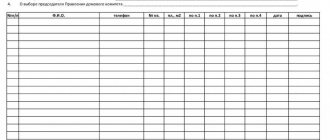The meeting of owners of apartments (and other premises, including non-residential ones) by the management bodies of the HOA or the audit commission of the HOA is held in two ways:
- In person . All hosts, by prior agreement, gather at the appointed time in a certain place. They personally discuss all the problems on the agenda, and personally vote on the items that need to be addressed.
- In absentia form . The owners of the premises and apartment owners are not present in person; instead, they fill out a voting ballot (which contains complete information on all problematic and important points) and send it to the HOA board.
It is the responsibility of HOA members to hold general meetings at least once a year. The timing and frequency of their holding are fixed in the HOA Charter. But on any day, if such a need arises, an extraordinary meeting can be convened.
Board members ensure that the minimum frequency is met.
How to hold a meeting?
First you need to decide on the reason for calling the meeting. Is it related to any exceptional situation or is it simply carried out “as scheduled” according to the Charter?
The preparatory stage of the meeting includes several stages:
- first you need to formulate the agenda: determine what topics will be discussed, what needs to be resolved, etc.,
- The “second step” is to immediately determine whether the event will be held in person or in absentia;
- set a date, exact time, and also, if the full-time form is chosen, the venue;
- if officials will be elected at the meeting, select candidates;
- prepare all the necessary documents: protocol forms, lists of residents, voting ballots and, if necessary, any additional papers (more details here);
- establish the share of each owner in the house.
After the preparatory activities are completed, it is necessary to inform the owners about the upcoming meeting . Usually, for this purpose, information sheets are printed, which responsible persons attach to the information board at each entrance and place in correspondence boxes.
The approximate contents of the information sheets are as follows:
- information about the initiator of the meeting (his full name and address, and if it is an organization, the name and location of the legal entity);
- information on the form of conduct (personal presence or absentee voting);
- time and place of the meeting (if in-person);
- deadlines for submitting voting ballots and the address to which they should be sent (if the form is absentee);
- list of issues discussed;
- an explanation of how and in what way you can familiarize yourself with all meeting materials.
Notices should be distributed no later than 10 days before the meeting.
Full-time
There is one condition, the failure of which makes the meeting impossible. Participants who appear must have - in total - more than 50% of all votes . This amount directly depends on the size of the apartment owner’s share.
During the meeting:
- residents present are registered (recommended, but not mandatory);
- the chairman and secretary of the meeting are elected;
- all items are considered sequentially, in accordance with the agenda (the agenda itself should not be changed during the meeting, otherwise confusion may arise and the event will be delayed);
- Voting is carried out by filling out ballots (giving your vote orally is unacceptable);
- the counting commission sums up the voting results and announces them;
- the results are recorded in a protocol kept by the secretary.
Within 10 calendar days after the meeting, all residents must be notified of the decisions made. For this purpose, you can post a notice at the entrances. All regulations must be followed by all, without exception, owners of apartments and other premises in the house - incl. and those who were unable to appear in person and cast their vote. But if any of them does not agree with the decisions, he has the right to appeal them in court in the next 6 months.
Challenging the HOA meeting in court
Everything that we said in the previous article about challenging a meeting of apartment building owners also applies to challenging a meeting of HOA members. An important difference is that only members of the HOA have the right to challenge the meeting. More precisely, non-members can also accept a claim... but when making a decision, the court will most likely indicate that their rights have not been violated.
In addition to conflict situations that are typical for meetings of owners (failure to notify the meeting, incorrect vote counting, suspicion of forgery of ballots), in HOAs a number of specific issues are added to the grounds for a legal dispute. This is, first of all, manipulations with the register of HOA members. As the meeting progresses, the chairmen can artificially inflate the number of the register (if it is necessary to show that the HOA in the house is legitimate, since it covers more than half of the votes of the owners), or, conversely, throw out “dead souls” from the register if it is necessary to reduce the base for calculating the quorum. Proving manipulation is usually very difficult.
Since the HOA is not bound by the requirement to provide a copy of the protocol to the Housing Inspectorate, the collection of ballots “retroactively” (sometimes within almost a year after signing the protocol) also flourishes. The courts are inclined not to consider this a significant violation if the signatures are not forged: in general, the chairmen can understand that collecting ballots from inactive residents is objectively not easy. A truly serious retroactive violation is the substitution of the protocol.
Still, in disputes between “dissenters” and the current HOA board, the board has an advantage, since it has more resources and is better prepared for a protracted war. But, if the violations are truly flagrant, and the plaintiffs are ready to go to the end, the illegal decisions will be canceled. However, it is often productive not to challenge an existing meeting, but to independently hold a new one.
Protocol
During the meeting, the secretary must take minutes. It records the agenda and voting results.
Sample
Housing legislation does not establish a specific and unchangeable form of protocol. The LCD only contains instructions on what elements and main points must be present.
Firstly, at the top of the protocol form you need to indicate the exact address of the house for which this HOA was created.
Secondly, below you should write where exactly the meeting is being held (for example, in one of the apartments of the house or in some non-residential premises) and when it began (exact time).
It is necessary to mark which of the residents initiated the meeting. Usually this is the chairman of the partnership, but each owner included in the HOA has the right of initiative.
It is very important at the beginning of the event to count the number of residents who have appeared and determine what percentage of the building’s premises (both residential and non-residential) they have. These values are also entered into the protocol. The fact is that any decisions of the meeting become invalid if the percentage of the premises owned by those gathered is less than 50.
The main part of the minutes is the agenda. In this section you need to specify what issues the owners intend to resolve during the meeting - for example, “Approval of the HOA Charter.” It is best to format this part as a numbered list.
Then the voting results for each issue are entered on the form and the decision made is formulated. The last part of the minutes summarizes the meeting: it briefly states whether the participants came to a consensus on all issues, whether all the tasks of the meeting were completed, and also again (but this time concisely and briefly) indicates what decisions were made.
The chairman and secretary put their signatures at the bottom of the form.
You can download samples below:
- minutes of the general meeting of members;
- minutes of the board meeting.
A meeting of owners and a meeting of HOA members - what is the difference?
Even the leaders of the HOA, not to mention ordinary residents, do not always understand the difference between the general meeting of owners of premises in an apartment building (general meeting of owners of premises in an apartment building) and the general meeting of members of the HOA (general meeting of the HOA). How are these meetings different?
Firstly, the composition of voters - those who have the right to take part in the meeting. all , whether members or non-members of the HOA, have the right to participate in the general meeting of owners of premises in In general, the HOA meeting is only for HOA members .
Secondly, the powers of the meetings , that is, the range of issues that they are authorized to resolve. The powers of the general meeting of owners of premises in an apartment building and the general meeting of the HOA are determined, respectively, by Articles 44-48 and 145-146 of the Housing Code of the Russian Federation. For example, questions about the use of a land plot under a house or other common property fall within the competence of the general meeting of owners of premises in an apartment building, and the establishment of tariffs for the maintenance of common property or the election of the board is the prerogative of the general meeting of the HOA. Confusion between types of meetings and incorrect determination of which issues are to be resolved at which meetings leads to the invalidity of their results.
Thirdly, the management organization (including the HOA) is obliged to send the minutes of the general meeting of owners of premises in an apartment building to the Housing Inspectorate, but the minutes of the general meeting of the HOA are not. However, this does not relieve the HOA from the obligation to post information in the GIS housing and communal services and other information systems, which we will discuss in another article.
Although the law states that owners are obliged to hold an annual general meeting of owners of premises in apartment buildings, the HOA has neither the obligation to organize it nor the responsibility for if it does not take place. But the obligation of the HOA to regularly hold a general meeting of the HOA arises from the fact that the HOA must annually approve a plan for the maintenance of common property, estimates of income and expenses, adopt tariffs, elect a board every two years, without which the chairman will not be able to confirm his powers and, as a result, , apply for a bank card to manage your account. In general, the lack of a quorum for the general meeting of the HOA is quite capable of giving rise to real problems for its management.
In practice, the general meeting of owners of premises in apartment buildings and the general meeting of the HOA are often combined. This can be done in two ways. Either two meetings are convened simultaneously and people fill out two different ballots, or one general ballot is compiled, in which those owners who are not members of the HOA vote only on issues of the general meeting of owners of premises in the apartment building, but do not vote on issues of the general meeting of the HOA.
Voting and election of the chairman of the board
The voting of owners is the main “legislative” mechanism in a particular house. It is held after discussion of almost every item on the agenda, so voting should be considered an integral part of any HOA meeting.
Owners' associations use two forms of voting: in-person and absentee. With the in-person option, meeting participants vote directly during the meeting at the location where it is held.
Absentee voting is carried out by filling out ballots sent to all apartment owners.
What is absentee voting?
In essence, this is the transfer of decisions of the owners on issues raised by the chairman of the HOA to the governing bodies of the partnership.
Absentee voting looks like this : the owner takes a ballot from his mailbox, reads it carefully and votes on each designated issue. The completed ballot is placed in the mailbox of the secretary of the board (or sent to another address that is written on this paper).
Absentee voting is especially convenient for homeowners in large buildings with many apartments. The more people there are, the more difficult it is for at least half of them to gather in one place at one time. Under these conditions, the correspondence form becomes the optimal solution.
If the ballot is about choosing a way to manage a house, the votes of the majority of the owners (over 50%) will be needed to make a decision. If such issues as repair of common property, use of the site, construction of various households are considered. structures or carrying out other large-scale work - you need to collect the votes of at least two-thirds of the total number of owners.
The voting results are counted by members of the HOA board or a commission specially created for this purpose.
Here is one example:
Protocol
The voting minutes are similar to the minutes of a meeting - they indicate the items voted on, the number of votes cast for each option, and the decision on the issue.
Where and when to submit?
By virtue of Part 1.1 of Art. 46 of the Housing Code of the Russian Federation of the Criminal Code is obliged to transfer documents within five days from the date of their receipt from the initiator of the meeting (see clause 3 of the Procedure). Unless otherwise stated, calendar days must be counted. It is important to record the date of receipt of documents. To do this, it is necessary to draw up an act of acceptance and transfer of documents, in which a list of documents should be given, the date of transfer should be reflected, and the signatures of the receiving and transferring parties should be affixed.
If the initiator of the general meeting is the manager of the MKD, it is quite logical to assume that the package of documents must be transferred to the GZHN body within five days from the date of drawing up the minutes.
In paragraph 2 of the Procedure it is specifically noted that the documents must be transferred to the body of the State Housing Property Committee of the constituent entity of the Russian Federation on the territory of which the apartment building is located, the owners of the premises in which held the general meeting.
Bulletin
The Housing Code specifies that the HOA voting ballot must contain the following information:
- a list of issues to vote on;
- date of final vote count;
- the address to which the completed ballot should be sent;
- fields for entering data about the owner (full name and data on the certificate of ownership).
The ballot provides three options for each issue: “for”, “against” and “abstained”.
If the meeting is held in absentia, the ballot (sample) must be sent to the owners along with the announcement of the meeting. If the event is held in person, this document is distributed to all participants at the stage of their registration at the very beginning of the event.
Procedure for re-electing the chairman
The chairman of the HOA is elected by the board meeting, choosing him from among its members. That is, only a member of the HOA board can become the chairman.
However, sometimes it becomes necessary to remove the head of the partnership. Unsatisfactory performance of one's duties, theft, voluntary desire to leave for some personal reasons - there can be many reasons. What to do in such cases?
The algorithm is simple! It will be necessary to call a special meeting, observing all the above conditions (10 days notice, agenda, etc.). At the meeting, candidates for this “supreme” position must be presented to the participants, after which the start of voting is announced.
Participants fill out ballots, and a commission counts the votes. It is immediately announced who is the winner and will now replace his predecessor. The decision is formalized as part of the minutes of the general meeting.
Over the next few days, be sure to let the tax authority and the housing inspection know about the change of board.
There is another way to re-elect the chairman. Meeting participants can choose not the chairman himself, but new members of the board . The latter, according to the traditional scheme, will choose a chairman from their circle.
Finally, you can not gather and vote at all, but leave the matter of re-election to the board (if the composition of this body does not need to be changed).
Power of attorney
If the homeowner is unable to attend the meeting in person, the law allows him to issue a power of attorney to another person to attend . The power of attorney should include all passport details and addresses of both the owner and his representative.
A power of attorney issued by an individual is certified only by his signature. But if the principal is a legal entity, in addition to the manager’s signature, you will need the seal of the HOA. Directly at the meeting, the presented power of attorney is signed by the chairman of the HOA.






